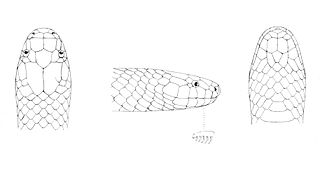
Pygopodidae, commonly known as snake-lizards, or flap-footed lizards, are a family of legless lizards with reduced or absent limbs, and are a type of gecko. The 47 species are placed in two subfamilies and eight genera. They have unusually long, slender bodies, giving them a strong resemblance to snakes. Like snakes and most geckos, they have no eyelids, but unlike snakes, they have external ear holes and flat, unforked tongues. They are native to Australia and New Guinea.

Hemidactylus is a genus of the common gecko family, Gekkonidae. It has 195 described species, newfound ones being described every few years. These geckos are found in all the tropical regions of the world, extending into the subtropical parts of Africa and Europe. They excel in colonizing oceanic islands by rafting on flotsam, and are for example found across most of Polynesia. In some archipelagoes, cryptic species complexes are found. Geckos like to live in and out of houses. They have been introduced to many areas around the world.

Pachydactylus is a genus of insectivorous geckos, lizards in the family Gekkonidae. The genus is endemic to Africa, and member species are commonly known as thick-toed geckos. The genus also displays rich speciation, having 58 distinct species identified when compared to other closely related gecko genera like Rhoptropus, most of which have emerged since 35Ma. It has been suggested that the reason for this rich speciation not from adaptive radiation nor nonadaptive radiation, but that the genus represents a clade somewhere between the two drivers of speciation. P. bibronii geckos have been used by NASA as animal models for experimentation.

Perochirus is a genus of geckos endemic to the Philippines, Oceania, and Japan, commonly known as Micronesian geckos, Polynesian geckos, or tropical geckos.

Pristurus is a genus of geckos native to Arabia and Socotra Island as well as the Middle East and the Horn of Africa. Species of Pristurus are commonly known as rock geckos .

Acanthodactylus is a genus of lacertid lizards, commonly referred to as fringe-fingered lizards, fringe-toed lizards, and spiny-toed lizards.

Nactus kunan is an extant species of slender-toe geckos described in 2012, and indigenous to the Admiralty Islands of Papua New Guinea. It is brightly coloured, and its specific name means "bumblebee" in the local Nali language.

Toxicocalamus is a genus of snakes in the family Elapidae. The genus is endemic to New Guinea.
Nactus cheverti, also known commonly as Chevert's gecko, the Fitzroy Island gecko, and the southern Cape York nactus, is a species of lizard in the family Gekkonidae. The species is endemic to Queensland in Australia.

Nactus pelagicus is a species of lizard in the family Gekkonidae. It is also known as the Pacific slender-toed gecko, pelagic gecko, and rock gecko. It is found from the Kai Islands through New Guinea, Melanesia and into the central Pacific, Micronesia, Tuamotu Archipelago, Fiji, Rotuma, Samoa, Solomon Islands, New Caledonia, Loyalty Islands, Vanuatu, Cook Islands, Tonga, Queensland in Australia, Northern Mariana Islands, and Guam.
Nactus aktites, the Madang coastal slender-toed gecko, is a species of lizard in the family Gekkonidae. It is endemic to Papua New Guinea.
The Madang slender-toed gecko is a species of lizard in the family Gekkonidae. It is endemic to Papua New Guinea.
The southern forest slender-toed gecko is a species of lizard in the family Gekkonidae. It is endemic to Papua New Guinea.
The Louisiade giant slender-toed gecko is a species of lizard in the family Gekkonidae. It is endemic to Papua New Guinea.
The Milne Bay pygmy slender-toed gecko is a species of lizard in the family Gekkonidae. It is endemic to Papua New Guinea.
The Milne Bay smooth-tailed slender-toed gecko is a species of lizard in the family Gekkonidae. It is endemic to Papua New Guinea.
The Kraus’s giant slender-toed gecko is a species of lizard in the family Gekkonidae. It is endemic to Papua New Guinea.
The Louisiade slender-toed gecko is a species of lizard in the family Gekkonidae. It is endemic to Papua New Guinea.
The southern mountains slender-toed gecko is a species of lizard in the family Gekkonidae. It is endemic to Papua New Guinea.
The Papuan slender-toed gecko is a species of lizard in the family Gekkonidae. It is endemic to Papua New Guinea.









